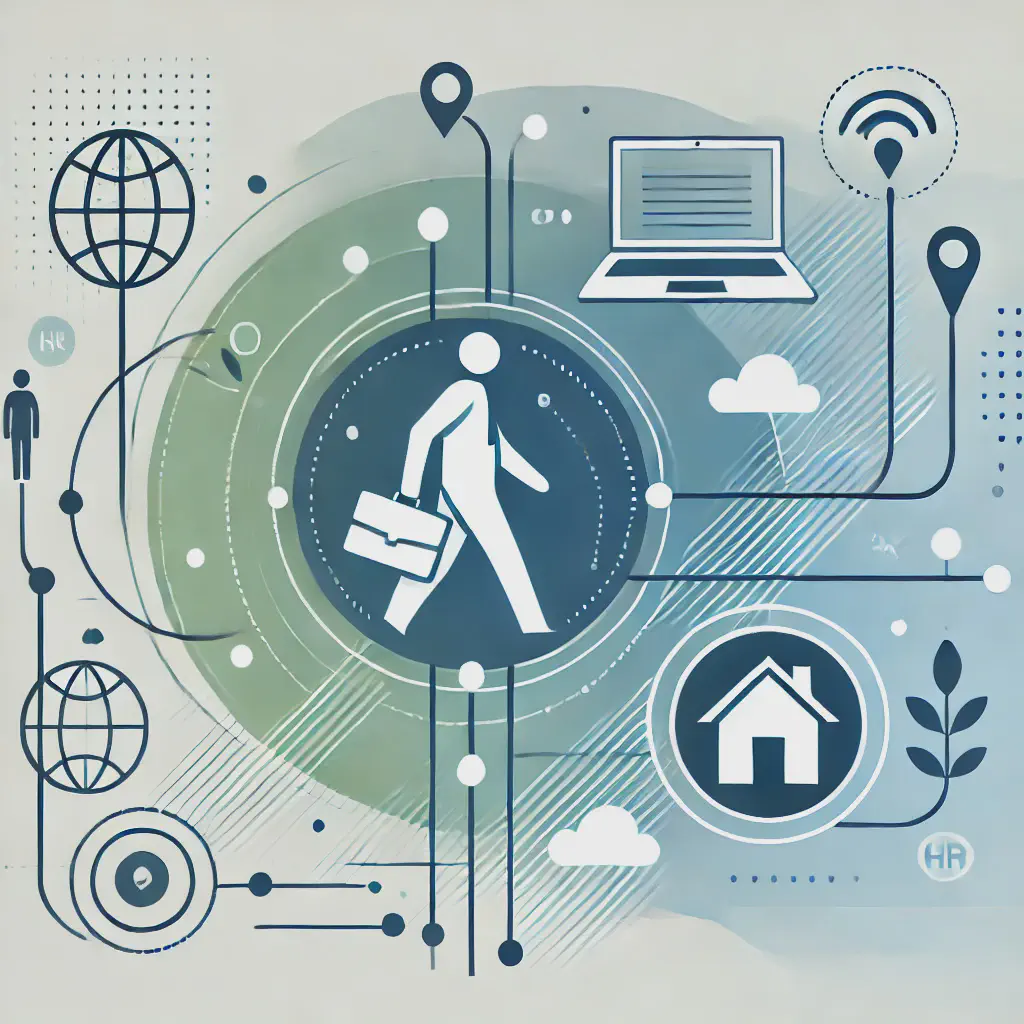
Navigating the Challenges of Remote Work: Strategies for HR Professionals
As an HR professional, how often do you encounter the silent struggle of an isolated remote employee? Remote work has transformed the landscape of employment, creating a pressing need for strategies that maintain productivity and engagement without the structure of a traditional office.
This shift has introduced unique challenges for HR professionals, from fostering company culture and communication to ensuring equitable and secure work environments. It is crucial to address these issues to uphold the well-being of employees and the overall health of the organization.
By reading this blog, you’ll gain actionable insights and strategies tailored for HR professionals to navigate the complexities of remote work. Discover how to enhance your team’s productivity, strengthen company culture, and promote a secure and equitable remote work environment, leading to a more resilient and adaptive organization.
1. Crafting a Well-Defined Remote Work Policy
Crafting a well-defined remote work policy is crucial for setting expectations and clarifying employee roles and responsibilities outside of the traditional office. HR professionals play a key role in formulating guidelines that address work hours, communication protocols, and performance metrics.
Engaging across departments to incorporate diverse insights ensures the policy is reflective of the company’s culture and objectives. Regular revisions are necessary to adapt to the changing needs of the organization and its employees.
Collaboration Across Departments
To ensure the remote work policy is comprehensive and inclusive, HR must collaborate with various departments. This allows for the inclusion of diverse perspectives and the identification of unique departmental needs.
For instance, the marketing team may require flexible work hours to manage international clients, while the IT department might need stricter security protocols for remote access. By involving multiple stakeholders, the policy becomes more robust and applicable to the entire organization.
Clear Communication Protocols
Establishing clear communication protocols is a cornerstone of effective remote work policies. This means setting up expectations for responsiveness, the preferred platforms for different types of communication (e.g., email for formal requests, messaging apps for quick queries), and guidelines for video conferencing.
A testimonial from a remote employee could highlight how these protocols have improved their daily workflow, adding a personal touch to the policy’s effectiveness.
Performance Assessment Criteria
Remote work calls for performance assessment criteria that accurately reflect the contributions of employees outside the traditional office setting. This might involve setting specific goals that can be measured, regardless of location, and regular virtual check-ins to discuss progress.
Case studies showcasing how these criteria have been successfully implemented can serve as a powerful endorsement of the policy’s practicality and fairness.
Regular Policy Review
The remote work landscape is continuously evolving, and so too should the policies that govern it. Regularly scheduled reviews of the remote work policy help ensure that it stays relevant and effective.
This could involve analyzing feedback from surveys, examining productivity data, or considering the latest technological advancements that could impact remote work dynamics. Sharing data and statistics from these reviews can emphasize the commitment to ongoing improvement.
2. Enhancing Team Cohesion Through Virtual Team-Building
HR professionals can boost team morale and combat the isolation of remote work by implementing engaging virtual team-building activities. These activities are designed to foster a sense of belonging and connection among employees, using digital platforms to simulate the camaraderie of in-office interactions.
From online games to virtual coffee breaks, HR should ensure these events cater to diverse interests and encourage personal connections.
Virtual Event Variety
Offering a mix of virtual events such as team challenges, themed trivia, and collaborative projects ensures that every team member finds something to enjoy. This variety prevents the monotony that can come with remote work and keeps team spirits high.
Inclusivity in Virtual Activities
Ensuring that virtual team-building activities are accessible to all employees, regardless of location or time zone, is crucial. This inclusivity strengthens team cohesion and ensures that everyone has the opportunity to participate and feel valued.
Utilizing Technology for Engagement
Leveraging technology platforms that are user-friendly and support interactive experiences is key to successful virtual team-building. These platforms can range from video conferencing tools to apps specifically designed for remote team interaction.
Regularly Scheduled Events
Establishing a regular schedule for virtual team-building activities helps create a rhythm for remote workers to look forward to. Consistency in these events contributes to a stable and connected remote work culture.
Feedback and Continuous Improvement
Collecting feedback after each virtual team-building event allows HR to refine activities based on employee preferences and effectiveness. This loop of feedback and improvement ensures that team-building efforts remain engaging and relevant.
Combining the need for strategic virtual team-building with actionable subpoints, HR professionals can effectively navigate the challenges of remote work and maintain a strong, cohesive workforce.
3. Investing in Technology and Training for Remote Work Success
For HR professionals to support remote work successfully, investing in the right technology and training is key. This involves identifying the tools employees require to work effectively from a distance, from communication platforms to project management software. It’s not just about the tech; employees need thorough training to navigate these digital tools confidently. Ensuring ongoing technical support is available is also vital to address any challenges swiftly. Continuous updates and refinement of training materials keep the remote workforce adept and agile.
Assessing Technological Needs
When assessing the technological needs of your workforce, it’s important to consider the variety of tasks employees perform. Customer service teams may need different tools compared to the marketing department. Conducting surveys and discussions can help pinpoint exactly what tools will boost productivity and facilitate collaboration. The goal is to equip your team with technology that makes remote work seamless, not to overwhelm them with unnecessary gadgets.
Providing Comprehensive Training
The key to effective use of technology is comprehensive training. This should include step-by-step guides, walkthrough videos, and live Q&A sessions. A mix of written and visual materials can cater to different learning styles, ensuring all employees become proficient with the new tools at their disposal. A well-trained team is an empowered team, so don’t skimp on this crucial step.
Ongoing Technical Support
Offering ongoing technical support is like providing a safety net for your remote team. It reassures them that help is just a call or email away, which is essential for maintaining productivity. Whether it’s troubleshooting software issues or assisting with hardware setup, a dedicated tech support team can make all the difference in a remote work setting.
Regular Training Updates
Just as technology evolves, so should your training materials. Regular updates to guides and tutorials not only keep your team up-to-date but also show that you’re committed to their continuous learning. This could be anything from a new feature in video conferencing software to best practices for online security. An informed team is a prepared team.
4. Enhancing Manager-Employee Connections in Remote Work
Establishing regular check-ins and support systems is an essential strategy for HR professionals to maintain strong communication and provide necessary assistance to remote employees. These structured interactions serve as a platform for discussing progress, addressing concerns, and fostering rapport between managers and their teams. HR should facilitate these check-ins with scheduling tools and promote peer support networks for a more connected remote workforce.
Structured Check-Ins
Regular, structured check-ins are invaluable for ensuring remote employees feel connected and supported. Managers can use calendar invites with reminders to maintain consistency. These sessions are an opportunity to discuss work progress, address concerns, and strengthen the manager-employee relationship. This is much like a coffee catch-up in a traditional office setting.
For instance, a quick weekly video call can simulate the face-to-face interactions that help build trust and rapport.
Peer Support Networks
Creating a peer support network can offer remote workers a sense of community and shared experience. Encouraging employees to form groups based on common interests or challenges can facilitate the exchange of ideas and best practices.
For example, a Slack channel dedicated to remote work tips or virtual lunch breaks can provide informal settings for employees to connect and support each other. This fosters a collaborative environment.
5. Promoting Flexible Working Hours
For HR professionals, acknowledging the diverse circumstances of remote employees by promoting flexible working hours is key to enabling peak performance and personal responsibility management. Clear guidelines on flexibility, coupled with core hours for necessary real-time collaboration, provide a balanced approach.
Tools for effective time management and scheduling can further support remote workers in maximizing productivity while maintaining their work-life balance.
Communicate Flexibility Benefits
Sharing success stories of how flexible hours have improved productivity and employee satisfaction can illustrate the value of this approach. It’s like when a friend tells you how shifting their work hours allowed them to attend their child’s soccer games—suddenly, the concept becomes relatable and appealing.
Providing real-life examples makes the policy more than just words on a page; it becomes a tangible benefit.
Guide Managers on Flexibility
Training managers on how to manage teams with varying schedules is critical. Imagine a conductor leading an orchestra where each musician plays at a different time; it would be chaos. Similarly, managers need guidance to harmonize team efforts while accommodating individual schedules.
Offering workshops or sharing best practices can equip them with the necessary skills.
Implement Core Hours
Establishing core hours when all team members are expected to be available helps to maintain a structure within the flexible work environment. Think of it as the ‘family dinner’ time at work—everyone shows up.
This ensures that, despite differing personal schedules, there is a predictable window for collaboration and communication.
Provide Time Management Tools
Offering resources such as scheduling software or productivity apps can be a game-changer for remote workers juggling various responsibilities. It’s akin to giving someone a map in a new city; it helps them navigate their day more efficiently.
These tools empower employees to manage their time well, which is beneficial for both the individual and the organization.
6. Fostering an Inclusive and Equitable Remote Work Environment
HR professionals play a pivotal role in ensuring remote work policies are equitable and foster an inclusive environment. Regularly examining communication channels, recognition, and professional development opportunities is crucial to identify and address any biases. Initiatives such as diversity training and inclusive hiring practices are fundamental in building a fair and productive remote work culture.
Review and Adjust Communication Channels
Examining communication patterns helps HR identify and rectify any imbalances, making sure all remote employees can voice their ideas and concerns. Analysis of data can reveal underrepresentation, which can lead to strategies for encouraging wider participation.
Recognize and Reward Equitably
Recognition and rewards should reflect merit, with HR setting an example by fairly distributing accolades. Testimonials from remote employees who feel valued for their contributions can emphasize the importance of equitable recognition and inspire others to strive for excellence.
Ensure Access to Professional Development
HR is responsible for providing remote employees with equal opportunities for learning and growth. Offering diverse online learning resources and virtual mentorship programs supports continuous professional development. Monitoring participation and gathering feedback can help customize these opportunities to meet employee needs.
Inclusive Hiring Practices
Embracing remote work enables HR to access a wider talent pool, promoting diversity in hiring. Showcasing case studies of successful hires from diverse backgrounds can highlight the positive impact of inclusive practices on the company’s culture and innovation.
Continuous Policy Review
An ongoing feedback loop is essential for HR to continuously improve remote work policies. Sharing personal experiences and reflections on the policy development process can provide valuable insights into the adaptive nature of remote work environments.
7. Enhancing Virtual Communication Channels
For remote work to thrive, HR professionals must focus on improving virtual communication channels to replicate the dynamic nature of in-person interactions. It’s not just about the tools; it’s about fostering various types of communication, from scheduled meetings to spontaneous chats. Training on virtual communication best practices and setting clear expectations for responsiveness and etiquette are crucial steps. By doing so, HR can create a more cohesive and efficient remote workforce, ensuring that every employee feels connected and valued.
Training on Communication Tools
To ensure that remote teams can communicate effectively, HR should provide training on how to use various virtual communication tools. This can include video conferencing, messaging apps, and project management software. By sharing best practices for each platform, employees can communicate more effectively, reducing misunderstandings and promoting productivity.
For example, a quick tutorial on using breakout rooms in video conferencing can facilitate smaller group discussions within larger meetings, helping to mimic the in-person experience.
Establishing Virtual Etiquette
Establishing guidelines for virtual etiquette is crucial. These guidelines could cover when to mute microphones, how to signal you wish to speak, or the appropriate use of emojis in professional communication. Sharing tips, like turning on video during meetings to foster connection, can make a big difference. A testimonial from a team that successfully adopted these practices could serve as a powerful endorsement of these guidelines.
Encouraging Diverse Communication Methods
HR should encourage the use of diverse communication methods to suit different contexts and needs. For instance, quick instant messages for immediate questions and email for less urgent, more detailed information. Offering case studies on how different methods have improved communication in other organizations can provide a real-world context and help employees understand the value of selecting the appropriate communication channel.
Regularly Reviewing Communication Practices
Creating a feedback loop for communication practices allows HR to gather insights on what’s working and what’s not. Regular surveys can help understand employee preferences and challenges, leading to continuous improvement in communication strategies. This can be complemented with data on communication tool usage, helping to paint a clearer picture of the team’s communication habits and needs.
8. Prioritizing Mental Health and Well-Being in Remote Work
HR professionals must prioritize the mental health and well-being of remote employees to maintain engagement and overall health. Initiatives such as virtual wellness programs, mental health days, and counseling services should be made readily available. Promoting a culture that values mental health encourages employees to utilize these resources without fear of stigma.
Regular communication about the importance of mental health and easy access to support services demonstrate the company’s commitment to its workforce.
Virtual Wellness Programs
Implementing virtual wellness programs, such as guided meditation sessions or fitness challenges, can help remote employees manage stress and maintain physical health. Sharing success stories from participants can inspire others to join and benefit from these programs.
A testimonial from an employee who found stress relief through a meditation program can be a powerful endorsement of its value.
Mental Health Days
Encouraging the use of mental health days helps employees recharge and prevent burnout. Companies can set an example by having leaders share their own experiences with taking mental health days, normalizing the practice.
Data showing the positive impact on productivity after such breaks can convince skeptics of the benefits.
Access to Counseling Services
Providing confidential access to counseling services supports employees dealing with personal or work-related challenges. Case studies of how counseling improved an employee’s well-being and performance can illustrate the effectiveness of this support.
Ensuring these services are promoted and easily accessible can make all the difference.
Communication and Culture
HR should communicate regularly about the importance of mental health, using quotes from leadership to reinforce the company’s commitment. Highlighting this messaging through various channels ensures that all remote employees are reached and feel supported.
A culture that openly talks about mental health fosters an environment of understanding and support.
Easy Access to Support
Making it simple for employees to access mental health resources is key. HR can provide a clear directory of available services and how to use them, along with a callout of the most helpful resources. Personal reflections from HR on the value of these tools can personalize the message and encourage utilization.
9. Professional Development for Remote Employees
HR professionals must prioritize the growth and career advancement of remote employees by providing diverse online learning resources and opportunities for cross-departmental collaboration. Virtual mentorship programs and tracking of employee feedback on development initiatives are key to tailoring programs that meet the workforce’s needs.
Regularly reviewing participation and outcomes ensures the alignment of professional development with the company’s strategic goals.
Access to Learning Resources
Providing access to a wide range of online learning tools, such as webinars and e-learning platforms, allows remote employees to enhance their skills and knowledge from anywhere. Incorporating data and statistics on course completion and employee progress can help HR illustrate the success of these programs.
Cross-Departmental Collaboration
Encouraging employees to engage in projects with teams from different departments can broaden their understanding and foster innovation. Sharing anecdotes of successful cross-departmental collaborations can inspire others to participate and learn from diverse perspectives.
Virtual Mentorship Opportunities
Implementing virtual mentorship can connect less experienced employees with seasoned professionals, facilitating knowledge transfer and career growth. Testimonials from participants in these mentorship programs can highlight their value and encourage broader participation.
Tailored Development Programs
Using employee feedback to customize professional development programs ensures relevance and effectiveness. Case studies of how tailored programs have led to career advancements for individuals can serve as powerful endorsements for the importance of personalized learning paths.
Monitoring and Adjusting Strategies
It’s crucial to continuously assess the effectiveness of professional development strategies through KPIs and adjust them based on feedback. Sharing personal reflections from HR professionals on the evolution of these strategies can provide insight into the ongoing commitment to employee growth.
10. Monitoring and Measuring Remote Work Success
HR professionals must employ a data-driven approach to gauge the success of remote work strategies, using targeted surveys and performance metrics to gather insights. Key Performance Indicators (KPIs) should be established to capture data on productivity and engagement, helping to understand the impact of remote work.
Regularly collected data can pinpoint areas for policy refinement and support informed decision-making. By analyzing this information, HR can adapt remote work practices to better serve the company and its remote workforce. This process ensures that remote work remains a viable and effective option for the organization.
Establish Clear KPIs
By setting clear KPIs related to remote work, such as project completion rates, employee satisfaction scores, and communication effectiveness, HR can precisely measure outcomes. Including data and statistics helps to objectively assess the remote work environment and make improvements where needed.
Conduct Regular Employee Surveys
Regular surveys can capture the remote workforce’s sentiment and provide a platform for employees to express their needs and challenges. Case studies can highlight the transformational impact that addressing survey feedback can have on employee satisfaction and productivity.
Use Performance Analytics Tools
Performance analytics tools can offer valuable insights into how remote work is affecting individual and team output. By sharing examples and anecdotes, HR can illustrate the benefits of these tools in understanding and enhancing the remote work experience.
Review and Adapt Policies
The feedback loop from employees should be used to review and adapt remote work policies regularly. Personal reflections from HR professionals on the evolution of these policies can show a commitment to continuous improvement and employee well-being.
11. Transparent and Frequent Communication with Remote Employees
For remote employees to feel connected and informed, HR must establish regular communication channels that deliver messages from leadership clearly and consistently. It’s essential to provide updates on company news, policy changes, and other important information through various channels to ensure all employees are reached. Fostering an atmosphere of openness builds trust and helps remote workers feel more integrated with the organization.
Encourage Leadership to Share Regular Updates
Leaders play a crucial role in setting the tone for transparency. By sharing regular updates and insights into company decisions, they can help employees feel included and valued. A simple yet effective technique could be a monthly video message from the CEO, which can humanize leadership and give a face to the voice guiding the company.
Use Multiple Communication Platforms
Not all employees engage with information in the same way. Some may prefer emails, while others might find quick messaging or social media-style platforms more engaging. By utilizing a diverse array of communication tools, HR can cater to different preferences, ensuring that important messages are received and understood by everyone.
Establish a Consistent Communication Schedule
Consistency is key to effective communication. Establishing a regular schedule for updates, such as a weekly newsletter or a recurring virtual town hall, can create a rhythm that employees can rely on. This also helps in managing expectations and reducing uncertainty about when and how information will be shared.
Promote Open Dialogue and Feedback
Two-way communication fosters a sense of community and collaboration. Encouraging employees to ask questions and provide feedback during virtual Q&A sessions or through anonymous suggestion boxes can give them a voice. This not only helps in addressing concerns but also in gathering valuable insights from the workforce.
Highlight Success Stories and Achievements
Sharing success stories and celebrating achievements can boost morale and inspire employees. Whether it’s a project milestone, an employee’s personal accomplishment, or a team’s collaborative success, highlighting these moments can create positive engagement and reinforce a sense of belonging.
12. Encouraging Work-Life Boundary Setting for Remote Employees
HR professionals play a crucial role in helping remote employees establish work-life boundaries, which is key to preventing burnout and promoting a healthy balance. Guidance on creating dedicated workspaces and disconnecting post-work can foster a culture that respects personal time. Tips on time management and self-care support sustainable productivity.
Establishing Dedicated Workspaces
Creating a physical boundary between work and personal life is essential for remote employees. By setting up a dedicated workspace, individuals can mentally shift into work mode and minimize distractions. This could be as simple as a specific desk or a designated corner in a room.
Anecdotes from successful remote workers can provide practical ideas and inspiration for setting up a productive home office environment.
Disconnecting After Work Hours
To prevent burnout, it’s important for remote employees to truly disconnect after work hours. This means setting specific times when work-related communications are off-limits, and sticking to them. Employers can lead by example, refraining from sending emails during evenings or weekends, unless urgent.
A testimonial from an employee who benefited from this practice can underscore its importance.
Time Management Training
Effective time management is crucial for maintaining work-life boundaries. HR can offer training sessions and resources to help employees manage their tasks and avoid the temptation to overwork. Sharing statistics on the benefits of good time management, such as increased productivity and lower stress levels, reinforces the value of these skills.
Promoting Self-Care
Encouraging employees to engage in self-care activities can improve their overall well-being and work performance. HR can organize virtual wellness programs and share tips on mindfulness, exercise, and healthy eating.
Personal reflections from HR professionals on their own self-care routines can make the message more relatable and motivate employees to prioritize their well-being.
Respecting Personal Time
A company culture that values and respects employees’ personal time is fundamental. HR can implement policies that support personal commitments, such as not scheduling meetings during common lunch hours or late in the day.
Case studies of companies that have successfully integrated such policies can demonstrate the positive impact on employee morale and retention.
13. Leveraging Remote Work for Diversity Hiring
HR professionals must design remote hiring processes that are inclusive, attract diverse talent, and remove biases. By leveraging the flexibility of remote work, companies can access a broader talent pool, leading to greater innovation and cultural richness within the organization. This approach not only enhances the company’s talent capabilities but also aligns with contemporary values of diversity and inclusion.
Crafting Inclusive Job Descriptions
An inclusive job description is the gateway to attracting a diverse candidate pool. It should be free of jargon, gender-coded words, and other language that might deter applicants from varied backgrounds. Consider using tools that analyze job postings for biased language to ensure a more inclusive approach. Including a statement about the company’s commitment to diversity can also set a positive tone.
Bias-Free Recruitment Practices
To minimize unconscious bias in the hiring process, HR can implement blind recruitment strategies, such as anonymizing resumes and utilizing structured interviews. These methods help assess candidates based on their skills and experience rather than personal characteristics.
Training hiring managers on recognizing and countering their own biases is also crucial.
Geographical Flexibility
The geographical flexibility inherent in remote work opens the door to candidates from different regions and backgrounds, which can be a game-changer for diversity. Emphasize the company’s openness to remote candidates in job postings to signal this advantage.
This can draw in talent that might not have been reachable otherwise, due to location constraints.
Inclusive Interviewing Techniques
Adopting inclusive interviewing techniques, such as offering virtual interviews and ensuring that interview panels are diverse, can make candidates feel more comfortable and valued. This also provides varied perspectives in the selection process, which helps in making more balanced hiring decisions.
Training interviewers on inclusive practices is key to this approach.
By focusing on creating inclusive job descriptions, implementing bias-free recruitment practices, taking advantage of geographical flexibility, and using inclusive interviewing techniques, HR can harness the power of remote work to build a diverse and vibrant workforce. These efforts not only contribute to a fairer hiring process but also to a more dynamic and innovative business environment.
14. Establishing a Feedback Loop for Remote Work Practices
To drive constant improvement in remote work experiences, HR should implement a systematic feedback loop. This not only shows employees that their opinions are valued but also provides critical data to refine remote work strategies.
By leveraging tools like surveys and suggestion boxes, HR can gather candid employee feedback and transform it into actionable improvements. Ensuring that remote work policies evolve to meet the ever-changing landscape of remote work dynamics is essential.
Implementing Regular Surveys
Regular surveys can act as a pulse check on the remote workforce, revealing insights into employee satisfaction and areas needing attention. These surveys should be short, frequent, and designed to encourage honest feedback.
By analyzing the responses, HR can pinpoint trends and issues. This enables driving targeted changes to enhance the remote working experience.
Creating Virtual Suggestion Boxes
Virtual suggestion boxes offer a continuous, informal avenue for employees to share ideas and concerns. This open-door approach can lead to innovative solutions and demonstrates that HR is approachable and responsive to employee needs.
Regular review of submissions and timely responses can further reinforce a culture of mutual respect and collaboration. As we draw this discussion to a close, I challenge you, the HR professionals navigating the complexities of remote work, to take a proactive step today. Start by implementing just one of the strategies we’ve covered, whether it’s initiating a feedback loop or tweaking your remote work policies based on employee insights. Remember, the smallest action can catalyze significant change.
So, I urge you to pick a strategy, set a goal, and begin the journey of transformation. Your commitment to continuous improvement will not only enhance the remote work experience for your employees but also drive the success of your organization in this digital era.
Let this be your moment to stretch your boundaries and lead with innovation and empathy. Are you ready to accept the challenge and grow? Start now, and let the journey unfold.




